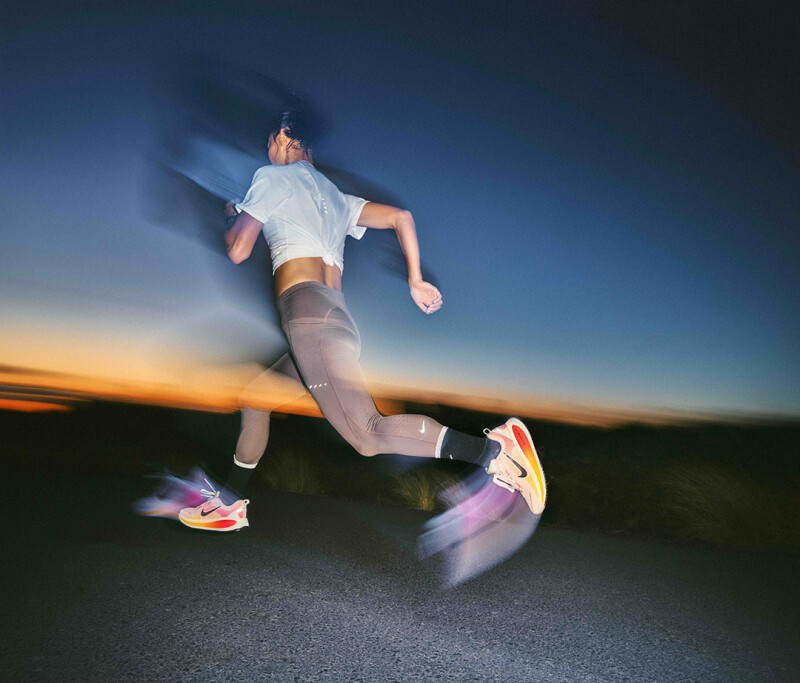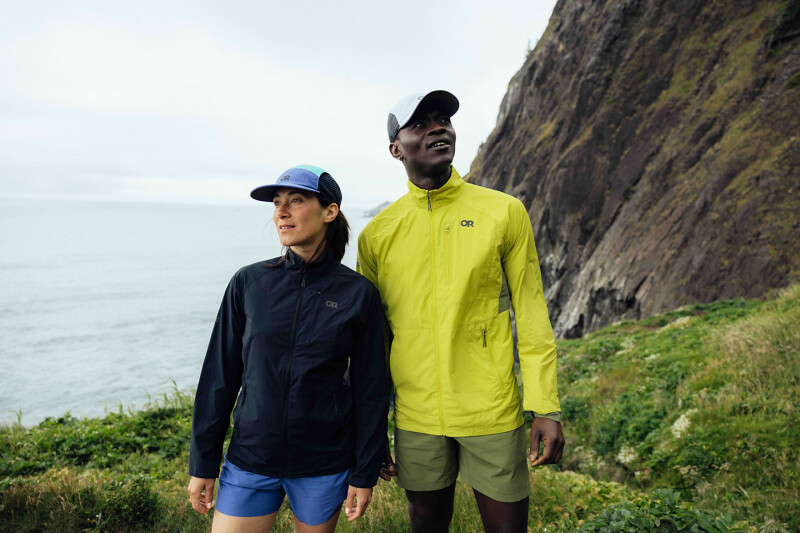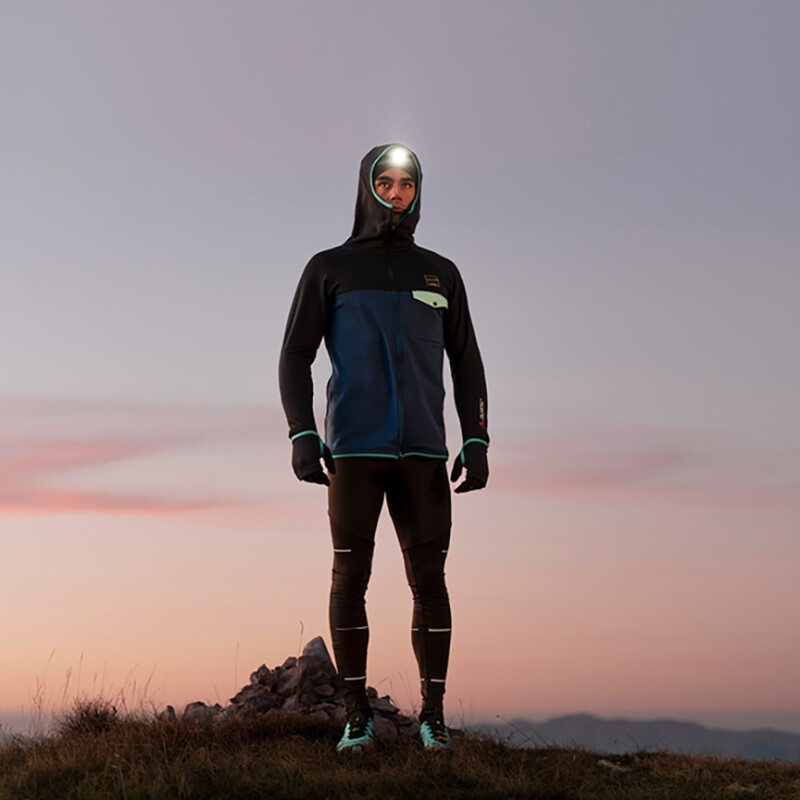More than two years ago, with the COVID-19 pandemic raging and escapism, particularly to the trails, becoming a national trend, Altra began a new footwear project under the working name “Green Mountain.”
The idea, according to Altra senior product line manager Alex Lind, was to create a new type of performance running shoe and to fill white space in Altra’s existing product lineup. While the Denver-based brand offered standout trail footwear and an ever-swelling collection of road options, Altra possessed no model blending the familiar, responsive ride of a road shoe with the grittier elements of a trail shoe.
“This was an experience missing in our line and a missed opportunity to bring new consumers into our brand,” Lind says.
The recently released Outroad represents Altra’s “Green Mountain” end game.
As intended, the Outroad straddles two worlds. It embraces the feel of a road shoe – accomplished with a decoupled outsole creating a more flexible ride and minimal TPU overlays on the upper for a sleeker, lighter feel – with the protective elements typical of its trail running shoes, such as a MaxTrac outsole and a multi-directional lug pattern. With 3mm outsole lugs, the Outroad delivers more aggressive grip than a road shoe yet represents a step back from the 4.5mm lugs found on Altra’s trail darling, the Lone Peak.
“Where the Lone Peak is the mountaintop, the Outroad is the foothills,” Lind says.
Altra’s Outroad is among a growing number of running shoes thoughtfully and quite intentionally designed to shift the dialogue from a trail shoe that can “exist” on the road to a true hybrid model that delivers on pavement as well as the trail — and is then explicitly marketed as such.
An Emerging Category
This past spring, inov-8, the offroad and mountain brand headquartered in the U.K., unveiled the Parkclaw G 280. Mashing up road and trail elements, the Parkclaw mixes inov-8’s bouncy, energy-returning G-FLY foam midsole and Boomerang footbed with a toe bumper, breathable zones on the upper and loads of “little cleats” – 98 to be exact – to provide a comfortable, stable ride on road or trail.
“You can have cushioning and grip at the same time. These features aren’t mutually exclusive,” inov-8 footwear product manager Bodil Oudshoorn says.
Around the same time, another European brand with a mountain mentality, Scarpa, expanded its running lineup with the debut of the Golden Gate ATR. Scarpa’s most cushioned running shoe to date and deliberately built to perform on a wide variety of terrain, the Golden Gate ATR uses medium and low densities of EVA in strategically placed locations to provide cushioning and high energy return, while a streamlined, seamless upper gives a road-like feel and a Super Gum rubber outsole provides traction and grip. (Of note, the 84-year-old Italian brand is dropping a Gore-Tex version of the Golden Gate ATR this fall to further expand the model’s reach.)
Even before the pandemic sent people to the trails in droves, however, footwear brands were beginning to lay claim to an intriguing market opportunity.
In mid-2020, for example, Saucony released the first version of its Canyon TR, a shoe the brand billed as “road to trail and back again.” The current Canyon TR 2 features springy PWRRUN cushioning alongside low-profile lugs for road-to-trail transition and a sleek engineered mesh upper reinforced with a flexible 3D-printed film for added protection and durability.
Reebok, Topo Run Ahead
Reebok, meanwhile, debuted the Floatride Energy 4 Adventure last month. The fourth iteration of its outdoor-inspired road-to-trail performance running shoe, the latest Adventure features a redesigned rubber outsole inspired by gravel bike tires.
“Larger, aggressive lugs on the perimeter of the outsole provide added traction in loose terrain while the tight lug pattern in the center section offers a smooth ride on pavement and hardpacked trails,” Reebok beamed upon introducing the Floatride Energy 4 Adventure.
Likewise, Topo Athletic entered the crossover category years ago with its MT franchise. Now in its fourth edition, Topo’s MT-4 promises “a comfortable, flexible and versatile ride” for runners heading straight from their “doorstep to the trailhead.” To accomplish that, Topo forgoes the traditional rock plate to create a flexible, soft underfoot feel, leans into an open, breathable mesh on the upper and utilizes Vibram XS Trek EVO on the outsole for traction and durability across varied terrain.
The road “feel” is important, Topo product manager Russ Stevens says, given how many individuals come to the trails from the road. A recent International Trail Running Association survey of 9514 trail runners found that two out of every three first ran on the road.
“We saw a certain segment of runners looking for product that would be familiar to them, especially as they moved from the road and embraced the trails more and more,” Stevens says of the MT franchise.
Welcome the Urban Trail Runner
Brands’ rationale for developing road-to-trail footwear ranges from the pragmatic to the opportunistic.
The continued growth of trail running domestically and globally has certainly emerged as one driving factor. Trail running participation was climbing year-over-year before the pandemic, often at a double-digit clip, while events like Park Run in the U.K., organized and free 5K races traversing different terrain, surged in popularity.
And the momentum hasn’t slowed, hinting at even more development to come in the trail category. According to data from AllTrails, trail running activity in the U.S. increased 57 percent in the first half of 2022 compared to 2021.
“There’s a melting pot of people wanting to exercise outdoors who are also interested in a different running experience and that has sparked a need for different kinds of products,” inov-8 trail and hike marketing manager Ali Wilkinson says.
This, of course, includes the growth of the so-called “urban trail runner.” In the U.S., more than 80 percent of the population lives in metropolitan areas, many of which do not offer immediate access to magnificent, technical trails. In Chicago and Houston, two metros no one would necessarily associate with grand off-road adventures, trail running recordings on AllTrails jumped 81 and 79 percent in the first six months of 2022 compared to the same period the previous year.
With urban consumers, in particular, a road-to-trail footwear option has definite appeal as an accessible, versatile option for a regular routine that includes groomed paths or foothills. In fact, Stevens says Topo’s MT-4 has proven particularly successful in these markets.
“It’s a product story that resonates with that customer since they’re not getting out on super serious terrain,” Stevens says.
Road-to-trail footwear also makes an appealing economic case, too, as a more versatile performance running shoe brings added value to a consumer’s purchasing decision. That reality, many brand reps note, cannot be overlooked as inflation rises and fears of an economic downturn hover above.
“People always appreciate versatility and the benefits versatility brings,” Wilkinson says.
The Marketing Angle
After creating thoughtful road-to-trail footwear, brands have turned to directly marketing the footwear as such. Topo, for example, bills the MT-4 as a road-to-trail option to leave no one guessing.
“Runners could, of course, use a trail shoe on the road, but it is not optimized for that experience,” Stevens says. “By calling the MT-4 out explicitly as a road-to-trail shoe, we’re able to explain why we developed it the way we did.”
Similarly, Wilkinson calls inov-8’s decision to market the Parkclaw as a road-to-trail option a “tactical” move for a brand most associated with serious trails.
“It was important for us to have a call out so we could open up the brand to a broader set of runners and reach individuals beyond our core consumer,” Wilkinson says.
Ditto for Scarpa in unveiling the Golden Gate ATR earlier this year.
“This is all about inclusion and trying to bring more people into trail running, which is why we’ve been so intentional and specific [in marketing the Golden Gate ATR as a road-to-trail shoe],” Scarpa North American VP–sales Mark Mathews says.
As interest in trail running climbs and new consumers break away from conventional trail shoes, the road-to-trail footwear category represents an enticing and likely-to-grow niche in the marketplace. In fact, that’s why Stevens says Topo is doubling down on shoes like the MT-4 that make a comfortable transition from pavement to trail.
In the coming months, Topo will introduce the Ultraventure 3. A more cushioned option for mild-to-moderate terrain, the Ultraventure 3 is visibly characterized by more segmented lugs and reduced lug heights on the outsole to better blend road and trail functionality.
“We see this category as one that will continue to grow because people want to get outdoors,” Stevens says.







